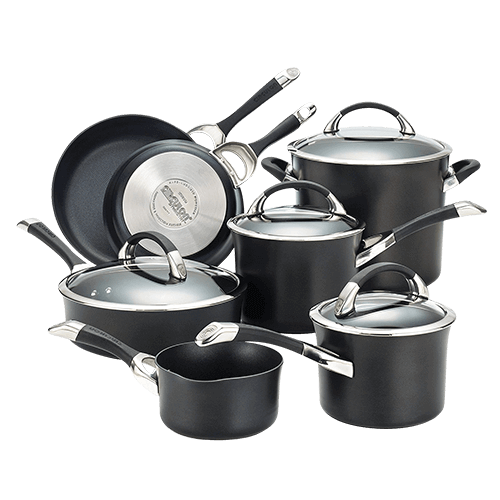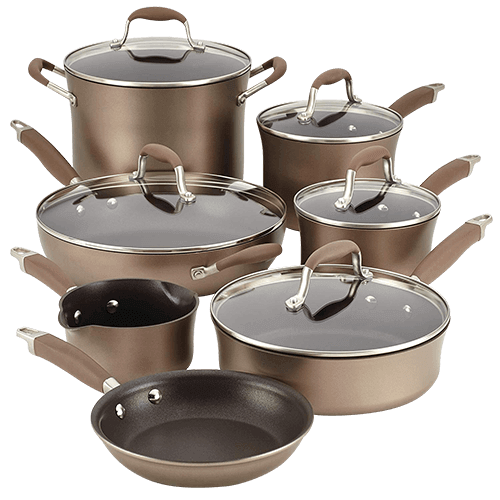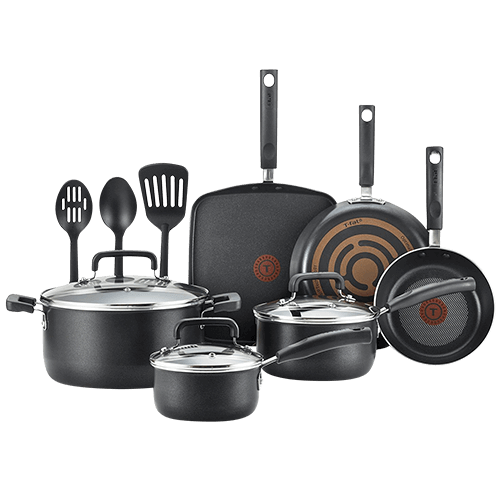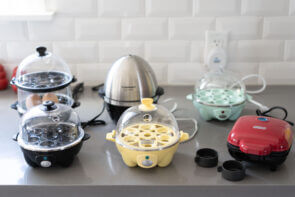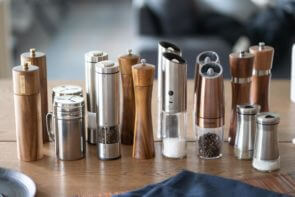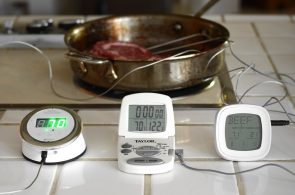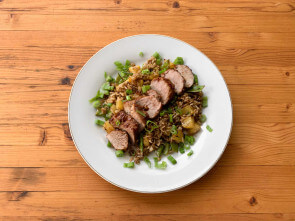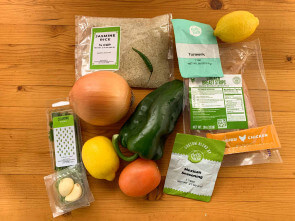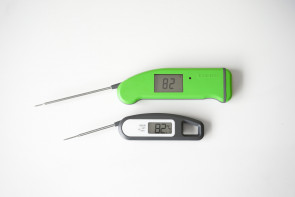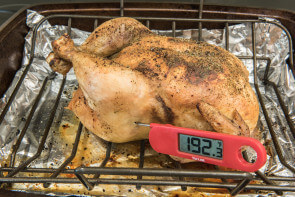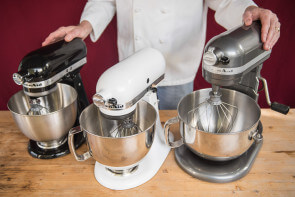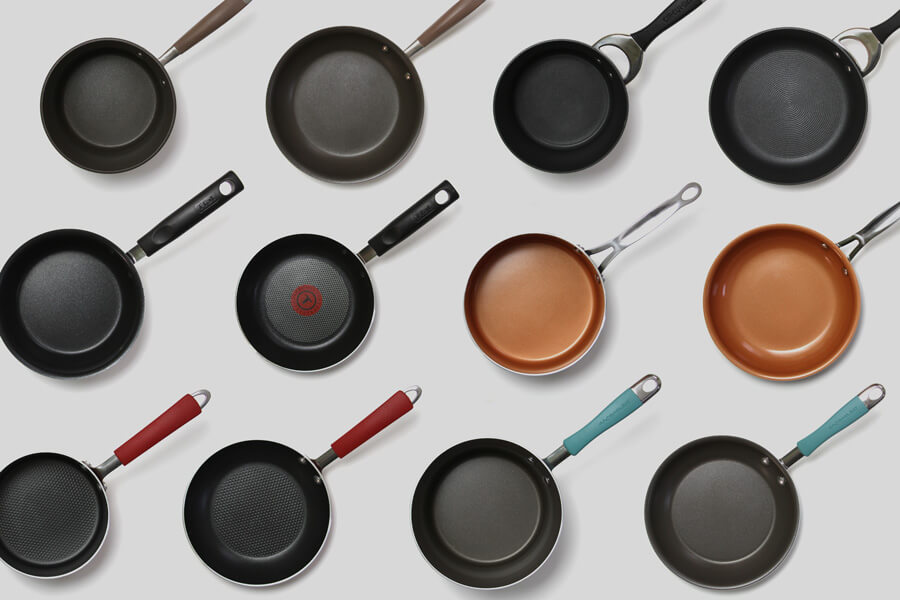
The 7 Best Nonstick Cookware Sets
After frying dozens of eggs, flipping stacks of pancakes and sizzling several pounds of fish using six of the most popular nonstick cookware sets, we concluded that the Circulon – Symmetry 11-Piece Set is the best nonstick cookware. The cooking surface of these pieces is incredibly resistant to sticky foods. It’s easy to clean, safe to use, and likely to stand up to years of use.
After frying dozens of eggs, flipping stacks of pancakes and sizzling several pounds of fish using six of the most popular nonstick cookware sets, we concluded that the Circulon – Symmetry 11-Piece Set is the best nonstick cookware. The cooking surface of these pieces is incredibly resistant to sticky foods. It’s easy to clean, safe to use, and likely to stand up to years of use.
Table of contents
- How we picked our finalists
- Compare the 7 nonstick cookware sets we tested
- What are nonstick surfaces?
- How to use nonstick cookware
- What to look for in a cookware set
- How we tested
- Best overall: Circulon – Symmetry
- Runner-up: Anolon – Advanced
- Best value: T-fal – Signature
- The other finalists
- The bottom line
How we picked our finalists
Before diving into this project, we check out some reputable food and home publications. Articles and reviews from Bon Appetit, Good Housekeeping, and Cooks Illustrated provided a great foundation. Posts from the Environmental Working Group and forums on WebMD also helped us begin to understand some of the concerns regarding particular nonstick surfaces.
Then, we crowdsourced to discover common complaints, experiences and expectations. From the 20-something progressing from cooking a late-night grilled-cheese sandwich to the proudest home chef, everyone has something to say about why they either love or hate their current cookware.
From our research, we found that the following characteristics and standards define what people are looking for in nonstick pans:
- Release: Do food items easily slide off the cooking surface without the use of oils?
- Heating: Does the surface heat evenly, avoiding cool spots and unevenly cooked food?
- Durability: Is the cookware likely to hold up to years of use?
- Cleaning: Are the pots and pans easily washed and cared for?
- Variety: Does the whole set cover all my cooking needs?
- Aesthetics: Will the cookware look great in my kitchen?
- Versatility: Can the items go in the oven? Can metallic utensils be used on the pans?
- Safety: Are the materials used in the nonstick coating safe for my family and the environment?
Compare the 7 nonstick cookware sets we tested
| Product Name | Price | Body Material | Handle Material | Oven Safe Temp. | Dishwasher Safe | Cooking Vessels | Lids |
|---|---|---|---|---|---|---|---|
| Analon | $$$$ | Stainless steel, hard anodized | Rubber-wrapped stainless steel | 400 °F | No | 7: 1 stockpot, 3 saucepans, 2 saute, 1 skillet | 5 |
| Circulon Symmetry | $$$ | Stainless steel base, hard anodized (PFOA, lead, cadmium free) | Rubber-wrapped metal | 400 °F | Yes | 7: 1 stockpot, 3 saucepans, 1 saute, 2 skillets | 4 |
| Faber ware Millenium | $ | Aluminum, porcelain enamel exterior, Dupont Teflon non stick | Rubber, silicone | 350 °F | No | 6: 1 stockpot, 2 saucepans, 1 saute, 2 skillets | 4 |
| Caraway | $$$$ | Aluminum core, non-stick ceramic coating (PTFE, PFOA, PFA, heavy metal-free) | Stainless steel | 550 °F | No | 4: 1 stockpot, 1 saucepan, 1 saute, 1 skillet | 4 |
| Gotham Steel | $$ | Aluminum, titanium and ceramic finish (PFOA, PTFE, PFOS free) | Metallic | 500 °F | No | 5: 1 stockpot, 2 saucepans, 1 saute, 1 skillet | 4 |
| T-Fal Signature | $ | Aluminum, (PFOA, lead, and cadmium free) | Plastic over metal | 350 °F | Yes | 6: 1 stockpot, 2 saucepans, 1 griddle, 2 skillets | 3 |
| Rachel Ray Cucina | $$ | Aluminum and sturdy hard enamel porcelain exteriors; certain colors PFOA-free | Silicone-wrapped stainless steel | 400 °F | No | 6: 1 stockpot, 2 saucepans, 1 saute, 2 skillets | 4 |
What are nonstick surfaces?
In the late 1930s, while working on a new alternative refrigerant at the DuPont company, Dr. Roy Plunkett stumbled on a combination of molecules that created a very slick, slippery surface. Dupont trademarked the compound Teflon, and for the next 30 years sold it for various military and industrial uses.
It wasn’t until the 1960s that we started to see Teflon and other similar chemicals being used in the construction of cookware. By bonding these chemicals to the cooking surface of pots and pans, they become incredibly resistant to sticky foods, making both cooking and cleaning easier and more enjoyable.
These coatings are almost universally made of fluoropolymers — large molecules in which fluorine atoms insulate carbon atoms. Fluorine is the key to producing a slippery surface because it’s highly resistant to reacting with other chemicals and it has a low coefficient of friction.
Polytetrafluoroethylene (PTFE) is a type of fluoropolymer most often used in cookware. Teflon, which is often misused as a generic descriptor of nonstick cookware, is the brand name for that very specific PTFE compound discovered by DuPont. Only one of our six finalists, Gotham Steel, uses a coating that is not PTFE-based.
In the past, the process of manufacturing PTFE required the use of Perfluorooctanoic Acid (PFOA). This practice has been nearly eliminated by major producers because PFOA is now understood to be a toxic pollutant linked to cancer. Other materials that used to be popular in cookware construction, like lead and cadmium, have also been largely phased out.
Safety concerns
Having spent several weeks immersed in the subject, we are well aware of the concern of possible health effects of using PTFE-based nonstick surfaces for food preparation. As a product-testing and recommendation company, we don’t want to focus on this aspect of the products, but we do believe that sharing the following information will help consumers.
The main concern with using nonstick cookware is the release of toxic gasses that may result from overheating pots and pans. At temperatures above 500 °F, the molecular compounds that comprise nonstick coating begin to break down. Once these atomic bonds are disrupted, potentially dangerous particles can be released into the air.
Polymer-fume fever is the name given to temporary flu-like symptoms including chills and headaches caused by exposure to airborne PTFEs. While these compounds begin to breakdown at 500 °F, significant and rapid decomposition will occur at 660 °F. According to the Environmental Working Group, Teflon in particular releases at least six toxic gasses — two of which are considered carcinogenic.
It’s important to understand that while there is legitimate cause for precaution, there is also widespread agreement among scientists and doctors that, when used correctly, nonstick cookware is entirely safe.
How to use nonstick cookware
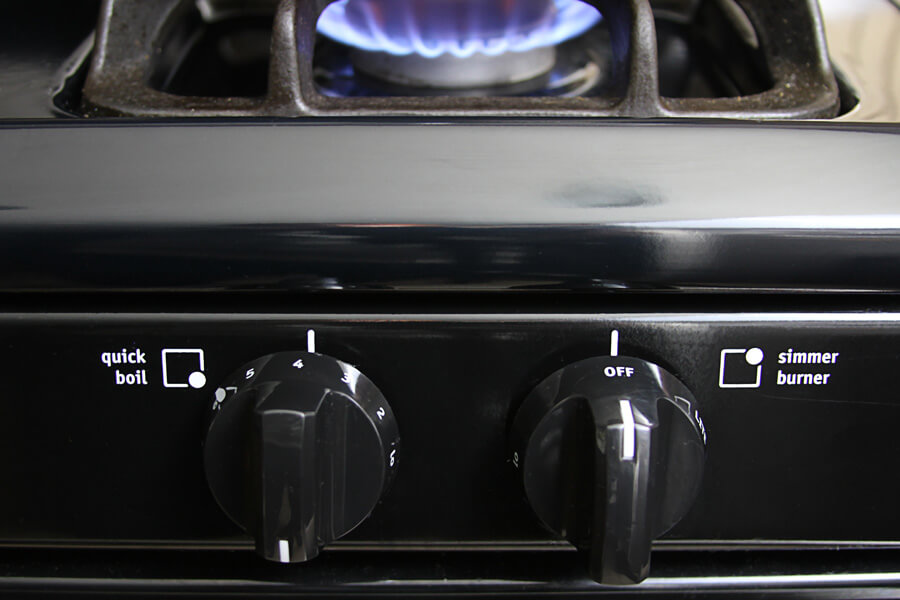
As mentioned above, the primary concern with nonstick cookware is overheating. Because it’s essential to prevent your pots and pans from exceeding 500 °F, you should only cook on low to medium heat. Even at medium heat it’s important to be mindful of how long the pan is in contact with the burner.
An empty pan will collect heat very quickly so if you must preheat a nonstick pan, use a coating of fat or oil, which will collect the heat instead of the pan itself. Heavier pans will generally take longer to heat up; therefore, choosing heavier cookware will allow you to safely cook a wider variety of foods. You should also turn on exhaust fans to improve ventilation in case dangerous toxins become airborne.
While many nonstick cookware sets are advertised as being oven-safe, you want to be extremely careful putting your cookware in the oven for long periods of time. You should also never use aerosol cooking sprays, as over time, a buildup of residue (from the soy lecithin in the spray) will make the nonstick surface ineffective.
Avoid chipping or otherwise damaging the pan. Even minor damage to the surface can harm the integrity of molecular bonds, causing the release of dangerous compounds. To keep your nonstick cookware scratch-free, avoid using abrasive cleaners like steel wool.
When to use nonstick cookware
Nonstick cookware is great for preparing many dishes, but it should not be the only option in your kitchen. Obviously, anything that requires high heat or prolonged exposure to heat should not be cooked using nonstick cookware. Steaks and burgers — really anything requiring a sear — should only be cooked in stainless steel or cast iron. Not only are those surfaces safer, but they also help produce a bit of that crustiness you’re looking for when cooking most meats.
Sautéed vegetables and sauces are also difficult to execute in nonstick cookware, because the surface is actually too slick. When preparing these dishes you’re aiming to get a lot of flavor from a thin layer of fat, juices, spices and oils — known as fond — that collects both on the bottom of the pan and on the food. The nature of nonstick cookware prevents the accumulation of this layer and leaves food tasting a bit more bland.
Particularly acidic foods, like tomatoes and lemon juice, can cause discoloration and damage to surfaces that are reactive, like nonstick coatings. These foods may also pick up a metallic taste.
Eggs, pancakes and hot sandwiches are all perfect for nonstick pans. However, if you’re making breakfast for the whole family, continue to lower the heat during your cooking session to maintain a pan temperature below 500 °F. You may be surprised by how quickly a nonstick skillet can reach that temperature.
Fish is another food that cooks well in nonstick cookware. It cooks quickly, and the skin, which often sticks to other cooking surfaces, is easily removed from a nonstick surface.
What to look for in a cookware set

Pieces: The sets we tested are all marketed as 10 to 12 pieces, which include a variety of pots, pans, lids, steamer baskets, spatulas and spoons. The sets are unique in their size, geometry, combination of offerings and versatility.
Weight: How much a particular pan weighs determines how fast it preheats, what you cook in it and how quickly it approaches a potentially dangerous 500 °F. While lighter cookware may be easier to use, clean, and store, heavier cookware is likely to last longer and perform better.
Materials: Beyond a nonstick coating, the cookware we tested utilizes a variety of materials, including aluminum, steel, ceramic and titanium. The different materials impact heating evenness, durability and user experience.
Aesthetics: While it’s unlikely you will own one set of cookware for the rest of your life, most pots and pans will be seen and used in your kitchen for years. It’s important to like the way they look and feel as well as how they’re stored in your kitchen.
Value: Like all of the products we test, we want to make sure that our readers are getting the value they’re looking for. You should be confident that the price you pay will give you a product and cooking experience you feel is worthy of the product’s cost.
How we tested
Release
We wanted to put our finalists through a series of real-life situations to test how easily different foods could slide off the cooking surface. All tests were conducted without using oil or any additional fat.

We started with eggs. First we fried an egg in the smaller skillet of each set; then we scrambled an egg in the same pan. The fried eggs were extremely easy to remove from each of the six pans. However, we found that when scrambling eggs, those pans with a textured surface often collected food particles in the grooves and dimples. The grooved skillets required a fair amount of effort to clean up.
We also put our finalists through a pancake test. Pancakes can be tricky: Even with lots of butter on the cooking surface, they often stick. We cooked a single pancake in the center of the largest pan in each set to see how easily the pancakes released. We discovered this was a useful measure of consistency as well. Some pans produced a golden-colored pancake that was uniformly cooked throughout while others cooked unevenly, often leaving us with a pancake that was darker in the middle.
Next, we cooked a half cup of oats in the smallest pot included in each set. We discovered that while the bottoms of each pot were all incredibly slippery, oatmeal stuck to the sides of some pots more than others. We also found that the rivets connecting each handle to the side of the pot were not always as flush on the inside wall of the pot. This led to pieces of food getting lodged in the tiny edges, making the pots more difficult to clean.

Finally, we prepared skin-on salmon filets in the largest skillet in each of the top six sets. Here, we noticed some significant distinction in the performance of the nonstick surface.
Heating
| Product | Time for Skillet Center to Hit 500 °F | Handle Temp After 5 Mins | Temp Variance: Pan’s Middle vs. Edge @ 3 Mins |
|---|---|---|---|
| Analon | 10:52 | 75 °F | 67 °F |
| Circulon Symmetry | 9:29 | 73 °F | 22 °F |
| Faberware Millenium | 3:45 | 82 °F | 41 °F |
| Caraway | 6:05 | 82 °F | 63 °F |
| Gotham Steel | 3:43 | 91 °F | 86 °F |
| T-Fal Signature | 4:04 | 74 °F | 78 °F |
| Rachel Ray Cucina | 5:18 | 76 °F | 35 °F |
In terms of the heated surface of the pan, we measured two main metrics:
- How fast does the pan take to reach 500 °F?
- Is the heat evenly distributed over the entire surface?
We set our gas stovetop to medium and used a digital infrared thermometer to monitor the rising temperature. After three minutes, we took readings from three different locations on the largest pan in each set (middle, left edge and right edge). We then calculated the difference between the highest and lowest temperature to determine the variance. The lower the variance, the more consistent the heat and the more evenly cooked the food.
We were particularly interested in how long it took each piece to reach the 500 °F mark, at which point the chemical bonds that create the nonstick coating become vulnerable to breaking down and emitting harmful particles.
Because a hot handle can be a surprise that may cause spilling or dropping, we also compared the heat accumulated in the handles. We placed a pan from each set over medium heat for five minutes and then took temperature readings of each handle. Some proved to be uncomfortably hot after just this short period of heat exposure.
Durability

You should expect to own a set of nonstick cookware for at least several years. While many of the products advertise much longer limited warranties, the coating — which ensures your food items don’t stick to the cooking surface — will deteriorate with normal use over time.
Our pots and pans were used pretty heavily in our test kitchen — but only for a few weeks. In order to simulate several years of use and to measure how resilient the products are, we scrubbed one piece from each set vigorously for 30 seconds with a textured scouring pad or synthetic steel wool.
After we scrubbed the smaller pan in each set, we then repeated our fried egg test directly over the impacted surface. Where before there was little distinction between all the products, allowing the egg to easily slide from the surface, now clear differences emerged.
It’s important to note that nonstick cookware should not be cleaned with a scouring pad or other abrasive cleaners, and our testing goes against the recommendations of the manufacturers. But we also believe the results indicate how likely each cook set might survive repeated cleanings.
User Experience
Finally, we took notes on what it was like to use each product. Some were easier to clean than others, and we think some styles are more impressive in their usability.
Others simply feel better constructed. Silicone and rubber handles feel better in your hand than exposed metal. Some sets include extra cookware or accessories you probably already own while others offer pieces that may be more versatile. Our testing resulted in a well-rounded evaluation of each product.
Best overall: Circulon – Symmetry
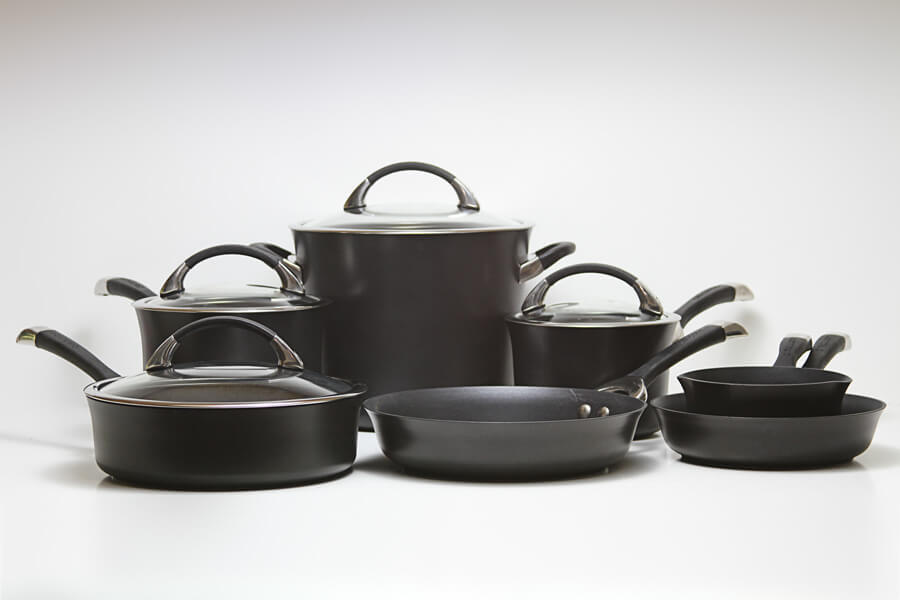
Our favorite set of nonstick cookware is the 11-piece Symmetry collection from Circulon, which includes seven pots and pans and four lids. These sharp-looking Circulon pots and pans proved incredibly resistant to the stickiest food while also providing the most consistent temperature across the cooking surface.
The Circulon Symmetry cookware is significantly heavier than most of the other sets we tested. The extra weight leads to pots and pans that heat slowly and evenly. In our test to see how long it took for a skillet to reach the 500 °F mark, where nonstick chemicals start to break down and become a health risk, the Circulon was the only one to last more than 10 minutes.
By absorbing heat slower, the pots and pans are much more versatile. They can be used to cook a larger variety of dishes without the nonstick surface deteriorating.
The Symmetry cookware also outperformed all the others we tested in terms of temperature consistency across the surface. Often, food will cook at a different pace because the temperature of the pan varies at different spots of the cooking surface. But the cooking surface of the Circulon line maintains a remarkably even temperature.
After three minutes over medium heat, the difference between the hottest and coolest spots on the Circulon skillet was just 22 °F. No other skillet came close.
It’s important to understand that all the cookware we tested provided a reliably stick-free cooking experience. Eggs, pancakes, oatmeal and fish all slid off the cooking surfaces effortlessly. And while the Circulon pan performed better than some others in our salmon filet test, the real distinction came after we scrubbed the pans with a scouring pad to simulate heavy use.
After just 30 seconds of vigorous scrubbing, most pans lost at least some of their nonstick ability, but the Circulon was seemingly unfazed by our attempt to inflict wear and tear on the nonstick surface. Advertised as safe for use with metal utensils, we don’t foresee any scratching issues from lots of use.
The heavier construction of these pots and pans simply make them feel high quality. The rubber-coated handles are comfortable and stay cool when exposed to heat. The pans are safe to put in both the dishwasher and the oven (up to 400 °F), increasing the versatility and convenience of the set.
Key takeaways:
- The Symmetry collection from Circulon offers slow, even heating ensures consistent cooking temperature and safety from the release of harmful toxins.
- The nonstick surface performs exceptionally well with a variety of foods, even after significant wear and tear.
- The pots and pans feel good, look great, and are easy to wash.
Runner-up: Analon – Advanced
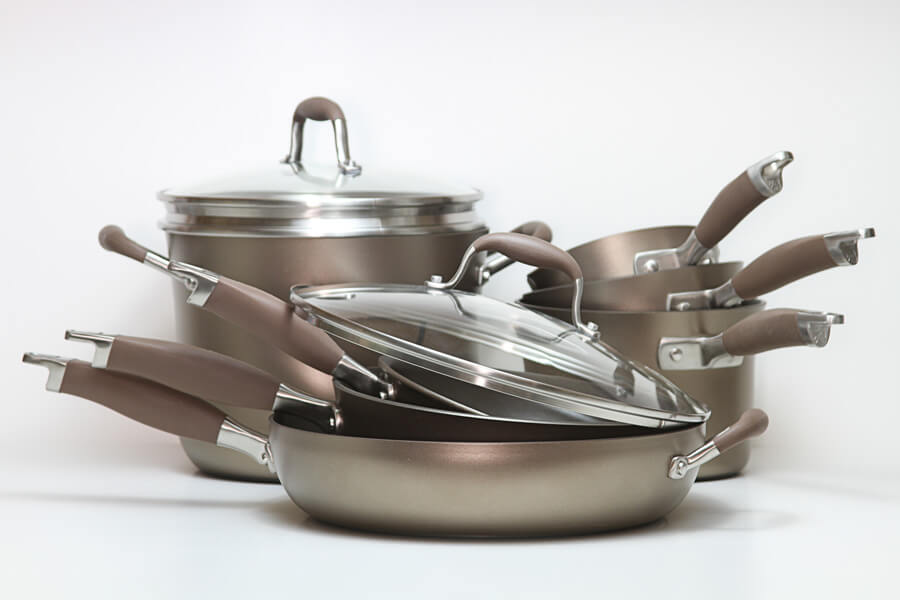
The Anolon – Advanced line of cookware is a great option for even the trickiest, stickiest tasks in the kitchen. The skillets and saucepans in this collection performed well in all our tests and provided a high-quality cooking experience. In our review of nonstick pans, we upgraded the Anolon – Advanced to our top pick.
In fact, it was a very close competition between the Anolon and Circulon, as both were hard to distinguish in “nonstickablility” and user experience. In the end, the Anolon trailed the Circulon set in both heating variance and time to reach 500 °F, leading it to become our runner up.
Each piece of the Anolon is constructed with three layers of nonstick coating. The manufacturer claims this process ensures superb performance over a long period of time, and we believe that to be true. The Anolon saute pan was unaffected by our scouring pad abuse test. The fried egg slid off the surface just as effortlessly as it had the first time, prior to scrubbing.
The triple-layer construction also provides a smooth cooking surface. Several other products rely on ridges or dimples to reduce abrasion that inevitably occurs over time. While these textured surfaces are optimal for many foods, some items, like scrambled eggs, can get lodged and burned inside the tiny crevices.
Like the Circulon Symmetry, the Anolon Advanced set is distinctly heavier than the others, which means it heats slower and more evenly. We also appreciated the smooth, slick surface and the high walls of the Anolon pots and pans. The shape of each piece encourages larger portions, easier stirring, and safer use.
Neither the Circulon nor the Anolon fool you by counting cheap plastic spatulas or spoons as cookware pieces. Within its 11 pieces of cookware, the Anolon Advanced series includes seven pot and pans and five lids — more than any other set.
Key takeaways:
- Anolon – Advanced’s hard anodized, flat cooking surface proves to be reliably nonstick and durable.
- Heavier, quality components prevent the cookware from accumulating dangerously high levels of heat.
- The high wall design of the Anolon pieces increase versatility and improve user experience.
Best value: T-fal – Signature
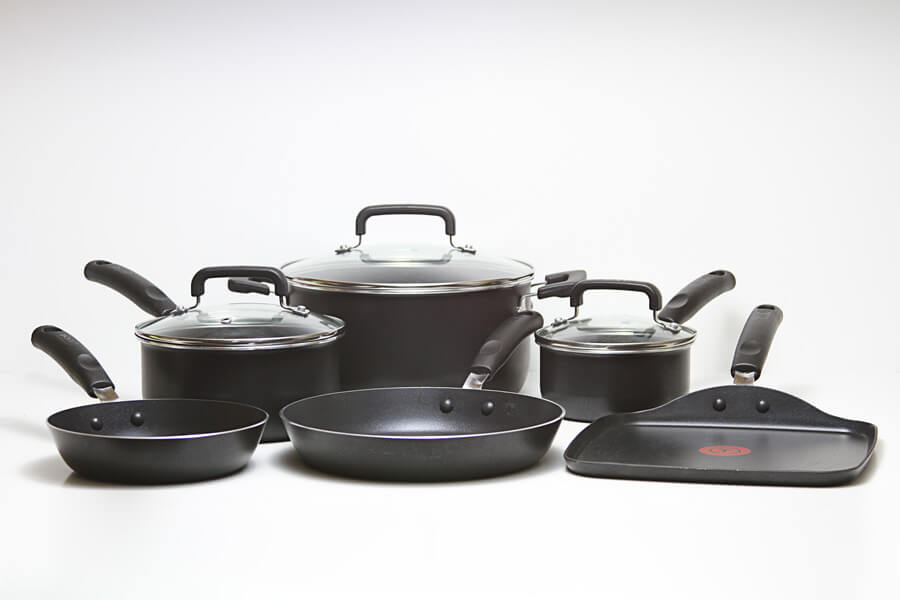
Cookware should be with you for a long time. You may use it daily, and we believe our recommendations are worthy of the price. That being said, for those wanting to spend a bit less, there are still great options.
The 12-piece signature series from T-fal is our choice for the best value set (under $100) of nonstick cookware. We like a lot of things about this collection of pots and pans — the nonstick performance in particular. Throughout our testing, food of all different kinds released easily from the T-fal cooking surface.
All of the pans in the T-fal Signature set feature a red logo heat indicator at the center of the pan. When the pan has absorbed the optimal level of heat, the logo’s blank spots fill in red, alerting you that the pan is ready. We found this unique feature useful because it takes the guesswork out of when to start cooking.
Another thing we liked, particularly when making pancakes, was the inclusion of a flat griddle. The T-fal is the only set we tested that offers a griddle, which makes preparing certain foods easier with increased cooking surface and easier access.
The T-fal set succeeded in separating itself from the other value cookware we tested in resilience and durability. Other pans we tested showed significant performance deterioration after scrubbing with the scouring pad, but the T-fal continued to allow food to slide off the surface easily.
The T-fal skillet reached 500 °F in just four minutes — longer than a few others we tested but not the best. We also discovered these pans to be pretty inconsistent in terms of the way they absorb heat. The difference from one side of the pan to the other was 78 degrees after three minutes on medium heat. It’s important to keep this in mind, particularly when preparing fish in T-fal cookware.
Key takeaways:
- The heat indicator and griddle are two unique features in the T-fal Signature cookware set.
- The skillets and saucepans held up to use and scrubbing better than the competition in the value category.
- At just $55-67, depending on color, the T-fal Signature cookware set is a bargain.
The cookware sets sold by Rachael Ray, Gotham Steel, and Faberware all provide a reliably stick-free cooking experience. There is little to no resistance when removing food from these pots and pans, and they all clean up quickly and easily.
Caraway

The Caraway Home Cookware Set is for the home cook who prefers a non-stick option and are prioritizing a modern and colorful aesthetic. They have a clean and aesthetic appearance, which is why we see this brand in videos from influencers. Think of it as the trendy millennial cookset.
This four-piece starter set comes with a Dutch oven, sauce pot, saute pan, and large skillet, including three lids, organizers, and cork trivets. Each non-stick pot and pans are made of non-stick ceramic-coated aluminum bodies and stainless steel handles. They feel substantial in weight when you lift them. The non-stick ceramic coating is free of PTFE (such as Teflon®), PFOA, heavy metals (like cadmium or lead), or other PFAs.
We followed their instructions while testing the Caraway pans and limited the heat settings to low and medium temperatures. The non-stick ceramic coating is slick gray, allowing even eggs to slip and slide across the pan without oil. There’s no searing of steaks or meat done in this, but that isn’t to say we couldn’t find many other uses.
The rules don’t stop there though–apparently, the non-stick surface is delicate. You aren’t supposed to use metal utensils on it, so we used silicone and our Epicurean utensils on these. Not the end of the world, but you simply can’t just abuse these like we can our carbon steel and cast iron. Our tests for boiling water to cook pasta and ramen were straightforward.
Cleaning the Caraway pots and pans was super easy because they’re so slick. Caraway instructs you to use less abrasive sponges to prevent damage to the ceramic coating. We never had any issues with stuck-on or stubborn foods. They wash and wipe down easily, like traditional non-stick pans.
Overall, the lack of versatility due to it not being bulletproof like carbon steel or cast iron makes us sometimes shy away from using Caraway. But this is true for most non-stick pan sets, not just Caraway. For specific uses, we reach for these pans because they are easy to clean and are great for frying eggs and boiling water for veggies and noodles. The Caraway Cookware Set is also our most expensive non-stick pans that’s priced at $325 for four pans (the least amount of pans for the highest price). But if you want non-stick and nontoxic pans with a modern design, the Caraway Cookware Set is our top choice.
Gotham Steel
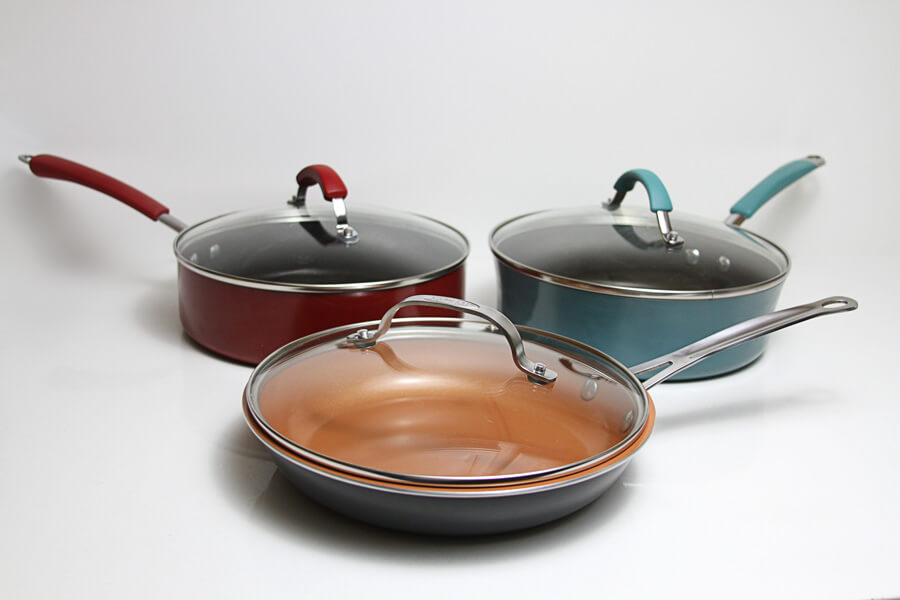
The skillet from Gotham Steel, made with titanium and ceramic, has a slick surface that performed the best in our test of salmon filets.This was the toughest challenge for our other finalists. Many of the filets left skin and fatty residue that stuck to the pan. The Gotham Steel repelled any oily build up, and the salmon was easily removed with one pass of a plastic spatula.
We also like the vegetable steamer insert for the largest pot, included in the Gotham set. No other collection offered a steamer, and it could be more useful for some consumers than a plastic spatula or slotted spoon.
Our concerns with the Gotham Steel include its quick accumulation of heat and lower long-term durability than other cookware. The Gotham Steel was the fastest to reach 500 °F at just three minutes and 43 seconds. It also demonstrated the highest variance; there was a difference of 86 degrees across the cooking surface, from one side of the pan to the other. A pan that gets too hot, too fast and has such an inconsistent temperature makes preparing some dishes difficult.
The Gotham Steel also has an exposed metallic handle. The other products in our top six use rubber, plastic or silicone to insulate the handle from heat and protect your hand. Without this barrier, we found the handle to get uncomfortably hot rather quickly, requiring use of oven mitts.
Faberware – Millenium
The Farberware – Millennium set may be our favorite set aesthetically. The dark cherry red porcelain is sharp and sophisticated and would look great in any kitchen. In our tests, the Farberware products were quick to reach that dangerous 500-degree level, but the cooking surface was uniformly heated, showing a low variance of just 41 °F.
In the end, what disappointed us about the Farberware was the nonstick technology reliant on dimples in the form of tiny indentations across the cooking surface, similar to the texture of a golf ball. The textured pans are marketed to help minimize abrasion, avoid scratching and prolong their effectiveness. However, we observed some food — for example, scrambled eggs and salmon fat — getting stuck in these crevices.
During the cooking process, this bit of food debris would continue to cook and burn into the surface, because it was not being picked up and flipped or stirred with the rest of the meal. This made cleaning the Farberware pots and pans a bit more difficult than the other products we tested.
Rachel Ray – Cucina
In the value category, the Rachael Ray – Cucina set was our second favorite line of cookware. Of the sets available for less than $100, the pots and pans from Rachael Ray were the slowest to reach 500 °F and showed the least variance — a difference of just 35 degrees, second only to our overall favorite from Circulon.
In fact, the Rachael Ray 12-piece set performed well in all our testing. It was strong against the scouring pad and slick enough to deal with salmon and scrambled eggs. The silicone-wrapped stainless steel handles feel great and the pans are safe in the oven, up to 400 degrees. While the Rachael Ray set is a viable value option, we just happened to like some of the features included in the T-fal collection a bit more.
The bottom line
Whichever cookware set you choose, remember how you use it is just as important. We recommend Circulon Symmetry as the best collection of nonstick cookware. The heavier components create pots and pans that heat safely, slowly, and evenly to make great food without a mess.
We also highly recommend the Anolon Advanced 11-piece set. We found the unique geometry of these pans, with their high walls, to provide an effortless cooking experience.
If you want the best product with the lowest financial investment, you may want to opt for the T-fal Signature set, which includes heat indicators and a griddle perfect for pancakes.
More Reviews
The 8 Best Electric Egg Cookers
Elite Gourmet - EGC-007B
The 8 Best Salt and Pepper Grinders
Merazi Living
Blue Apron
Martha & Marley Spoon
HelloFresh Meal Delivery Kit Review
HelloFresh
The Best Dry Food Storage Containers
Progressive - Prepworks


